10.1 A New Political Style: From John Quincy Adams to Andrew Jackson
Learning Objectives
By the end of this section, you will be able to:
- Explain and illustrate the new style of American politics in the 1820s
- Describe the policies of John Quincy Adams’s presidency and explain the political divisions that resulted
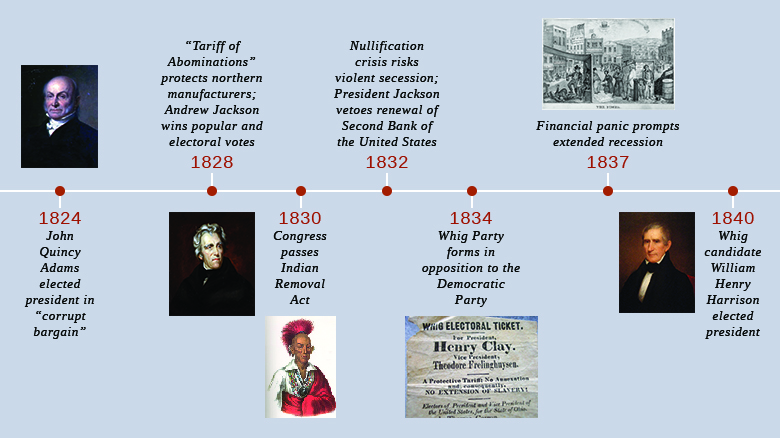
In the 1820s, American political culture gave way to the democratic urges of the citizenry. Political leaders and parties rose to popularity by championing the will of the people, pushing the country toward a future in which a wider swath of citizens gained a political voice. However, this expansion of political power was limited to White men; women, free Black people, and Native Americans remained—or grew increasingly—disenfranchised by the American political system.
The Decline of Federalism
The first party system in the United States shaped the political contest between the Federalists and the Democratic-Republicans. The Federalists, led by Washington, Hamilton, and Adams, dominated American politics in the 1790s. After the election of Thomas Jefferson—the Revolution of 1800—the Democratic-Republicans gained ascendance. The gradual decline of the Federalist Party is evident in its losses in the presidential contests that occurred between 1800 and 1820. After 1816, in which Democratic-Republican James Monroe defeated his Federalist rival Rufus King, the Federalists never ran another presidential candidate.
Before the 1820s, a code of deference had underwritten the republic’s political order. Deference was the practice of showing respect for individuals who had distinguished themselves through military accomplishments, educational attainment, business success, or family pedigree. Such individuals were members of what many Americans in the early republic agreed was a natural aristocracy. Deference shown to them dovetailed with republicanism and its emphasis on virtue, the ideal of placing the common good above narrow self-interest. Republican statesmen in the 1780s and 1790s expected and routinely received deferential treatment from others, and ordinary Americans deferred to their “social betters” as a matter of course.
For the generation who lived through the American Revolution, for instance, George Washington epitomized republican virtue, entitling him to great deference from his countrymen. His judgment and decisions were considered beyond reproach. An Anglican minister named Mason Locke Weems wrote the classic tale of Washington’s unimpeachable virtue in his 1800 book, The Life of Washington. Generations of nineteenth-century American children read its fictional story of a youthful Washington chopping down one of his father’s cherry trees and, when confronted by his father, confessing: “I cannot tell a lie” (Figure 10.3). The story spoke to Washington’s unflinching honesty and integrity, encouraging readers to remember the deference owed to such towering national figures.
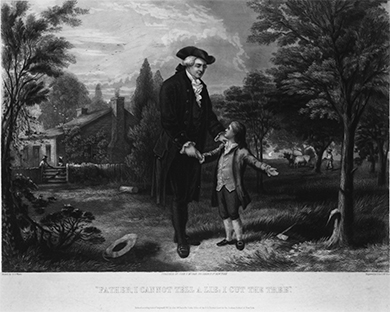
Washington and those who celebrated his role as president established a standard for elite, virtuous leadership that cast a long shadow over subsequent presidential administrations. The presidents who followed Washington shared the first president’s pedigree. With the exception of John Adams, who was from Massachusetts, all the early presidents—Thomas Jefferson, James Madison, and James Monroe—were members of Virginia’s elite slaveholder aristocracy.
Democratic Reforms
In the early 1820s, deference to pedigree began to wane in American society. A new type of deference—to the will of the majority and not to a ruling class—took hold. The spirit of democratic reform became most evident in the widespread belief that all White men, regardless of whether they owned property, had the right to participate in elections.
Before the 1820s, many state constitutions had imposed property qualifications for voting as a means to keep democratic tendencies in check. However, as Federalist ideals fell out of favor, ordinary men from the middle and lower classes increasingly questioned the idea that property ownership was an indication of virtue. They argued for universal manhood suffrage, or voting rights for all White male adults.
New states adopted constitutions that did not contain property qualifications for voting, a move designed to stimulate migration across their borders. Vermont and Kentucky, admitted to the Union in 1791 and 1792 respectively, granted the right to vote to all White men regardless of whether they owned property or paid taxes. Ohio’s state constitution placed a minor taxpaying requirement on voters but otherwise allowed for expansive White male suffrage. Alabama, admitted to the Union in 1819, eliminated property qualifications for voting in its state constitution. Two other new states, Indiana (1816) and Illinois (1818), also extended the right to vote to White men regardless of property. Initially, the new state of Mississippi (1817) restricted voting to White male property holders, but in 1832 it eliminated this provision.
In Connecticut, Federalist power largely collapsed in 1818 when the state held a constitutional convention. The new constitution granted the right to vote to all White men who paid taxes or served in the militia. Similarly, New York amended its state constitution in 1821–1822 and removed the property qualifications for voting.
Expanded voting rights did not extend to women, Native, or free Black people in the North. Indeed, race replaced property qualifications as the criterion for voting rights. American democracy had a decidedly racist orientation; a White majority limited the rights of Black minorities. New Jersey explicitly restricted the right to vote to White men only. Connecticut passed a law in 1814 taking the right to vote away from free Black men and restricting suffrage to White men only. By the 1820s, 80 percent of the White male population could vote in New York State elections. No other state had expanded suffrage so dramatically. At the same time, however, New York effectively disenfranchised free Black men in 1822 (Black men had had the right to vote under the 1777 constitution) by requiring that “men of color” must possess property over the value of $250.
Party Politics and the Election of 1824
In addition to expanding White men’s right to vote, democratic currents also led to a new style of political party organization, most evident in New York State in the years after the War of 1812. Under the leadership of Martin Van Buren, New York’s “Bucktail” Republican faction (so named because members wore a deer’s tail on their hats, a symbol of membership in the Tammany Society) gained political power by cultivating loyalty to the will of the majority, not to an elite family or renowned figure. The Bucktails emphasized a pragmatic approach. For example, they opposed the Erie Canal project at first, but when the popularity of the massive transportation venture became clear, they supported it.
One of the Bucktails’ greatest achievements in New York came in the form of revisions to the state constitution in the 1820s. Under the original constitution, a Council of Appointments selected local officials such as sheriffs and county clerks. The Bucktails replaced this process with a system of direct elections, which meant thousands of jobs immediately became available to candidates who had the support of the majority. In practice, Van Buren’s party could nominate and support their own candidates based on their loyalty to the party. In this way, Van Buren helped create a political machine of disciplined party members who prized loyalty above all else, a harbinger of future patronage politics in the United States. This system of rewarding party loyalists is known as the spoils system (from the expression, “To the victor belong the spoils”). Van Buren’s political machine helped radically transform New York politics.
Party politics also transformed the national political landscape, and the election of 1824 proved a turning point in American politics. With tens of thousands of new voters, the older system of having members of Congress form congressional caucuses to determine who would run no longer worked. The new voters had regional interests and voted on them. For the first time, the popular vote mattered in a presidential election. Electors were chosen by popular vote in eighteen states, while the six remaining states used the older system in which state legislatures chose electors.
With the caucus system defunct, the presidential election of 1824 featured five candidates, all of whom ran as Democratic-Republicans (the Federalists having ceased to be a national political force). The crowded field included John Quincy Adams, the son of the second president, John Adams. Candidate Adams had broken with the Federalists in the early 1800s and served on various diplomatic missions, including the mission to secure peace with Great Britain in 1814. He represented New England. A second candidate, John C. Calhoun from South Carolina, had served as secretary of war and represented the slaveholding South. He dropped out of the presidential race to run for vice president. A third candidate, Henry Clay, the Speaker of the House of Representatives, hailed from Kentucky and represented the western states. He favored an active federal government committed to internal improvements, such as roads and canals, to bolster national economic development and settlement of the West. William H. Crawford, a slaveholder from Georgia, suffered a stroke in 1823 that left him largely incapacitated, but he ran nonetheless and had the backing of the New York machine headed by Van Buren. Andrew Jackson, the famed “hero of New Orleans,” rounded out the field. Jackson had very little formal education, but he was popular for his military victories in the War of 1812 and in wars against the Creek and the Seminole. He had been elected to the Senate in 1823, and his popularity soared as pro-Jackson newspapers sang the praises of the courage and daring of the Tennessee slaveholder (Figure 10.4).
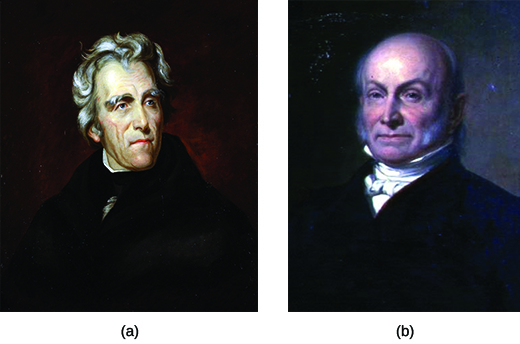
Results from the eighteen states where the popular vote determined the electoral vote gave Jackson the election, with 152,901 votes to Adams’s 114,023, Clay’s 47,217, and Crawford’s 46,979. The Electoral College, however, was another matter. Of the 261 electoral votes, Jackson needed 131 or better to win but secured only 99. Adams won 84, Crawford 41, and Clay 37. Because Jackson did not receive a majority vote from the Electoral College, the election was decided following the terms of the Twelfth Amendment, which stipulated that when a candidate did not receive a majority of electoral votes, the election went to the House of Representatives, where each state would provide one vote. House Speaker Clay did not want to see his rival, Jackson, become president and therefore worked within the House to secure the presidency for Adams, convincing many to cast their vote for the New Englander. Clay’s efforts paid off; despite not having won the popular vote, John Quincy Adams was certified by the House as the next president. Once in office, he elevated Henry Clay to the post of secretary of state.
Jackson and his supporters cried foul. To them, the election of Adams reeked of anti-democratic corruption. So too did the appointment of Clay as secretary of state. John C. Calhoun labeled the whole affair a “corrupt bargain” (Figure 10.5). Everywhere, Jackson supporters vowed revenge against the anti-majoritarian result of 1824.
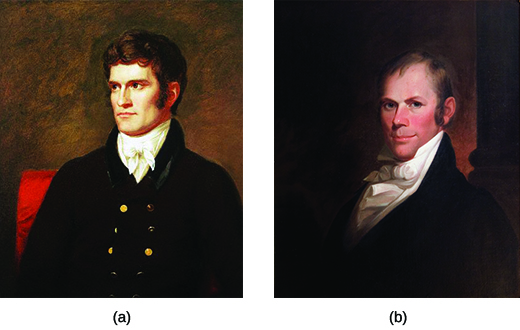
The Presidency of John Quincy Adams
Secretary of State Clay championed what was known as the American System of high tariffs, a national bank, and federally sponsored internal improvements of canals and roads. Once in office, President Adams embraced Clay’s American System and proposed a national university and naval academy to train future leaders of the republic. The president’s opponents smelled elitism in these proposals and pounced on what they viewed as the administration’s catering to a small, privileged class at the expense of ordinary citizens.
Clay also envisioned a broad range of internal transportation improvements. Using the proceeds from land sales in the West, Adams endorsed the creation of roads and canals to facilitate commerce and the advance of settlement in the West. Many in Congress vigorously opposed federal funding of internal improvements, citing among other reasons that the Constitution did not give the federal government the power to fund these projects. However, in the end, Adams succeeded in extending the Cumberland Road into Ohio (a federal highway project). He also broke ground for the Chesapeake and Ohio Canal on July 4, 1828.
Click and Explore
Visit the Highway History: Back in Time: National Road page on the Federal Highway Administration’s website and the Chesapeake and Ohio Canal National Historic Park to learn more about transportation developments in the first half of the nineteenth century. How were these two projects important for westward expansion?
Tariffs, which both Clay and Adams promoted, were not a novel idea; since the birth of the republic, they had been seen as a way to advance domestic manufacturing by making imports more expensive. Congress had approved a tariff in 1789, for instance, and Alexander Hamilton had proposed a protective tariff in 1790. Congress also passed tariffs in 1816 and 1824. Clay spearheaded the drive for the federal government to impose high tariffs to help bolster domestic manufacturing. If imported goods were more expensive than domestic goods, then people would buy American-made goods.
President Adams wished to promote manufacturing, especially in his home region of New England. To that end, in 1828 he proposed a high tariff on imported goods, amounting to 50 percent of their value. The tariff raised questions about how power should be distributed, causing a fiery debate between those who supported states’ rights and those who supported the expanded power of the federal government (Figure 10.6). Those who championed states’ rights denounced the 1828 measure as the Tariff of Abominations, clear evidence that the federal government favored one region, in this case the North, over another, the South. They made their case by pointing out that the North had an expanding manufacturing base while the South did not. Therefore, the South imported far more manufactured goods than the North, causing the tariff to fall most heavily on the southern states.
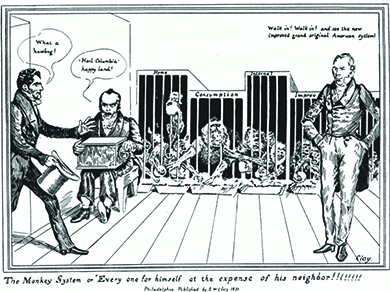
The 1828 tariff generated additional fears among southerners. In particular, it suggested to them that the federal government would unilaterally take steps that hurt the South. This line of reasoning led some southerners to fear that the very foundation of the South—slavery—could come under attack from a hostile northern majority in Congress. The spokesman for this southern view was President Adams’s vice president, John C. Calhoun.
Defining American
John C. Calhoun on the Tariff of 1828
Vice President John C. Calhoun, angry about the passage of the Tariff of 1828, anonymously wrote a report titled “South Carolina Exposition and Protest” (later known as “Calhoun’s Exposition”) for the South Carolina legislature. As a native of South Carolina, Calhoun articulated the fear among many southerners that the federal government could exercise undue power over the states.
If it be conceded, as it must be by every one who is the least conversant with our institutions, that the sovereign powers delegated are divided between the General and State Governments, and that the latter hold their portion by the same tenure as the former, it would seem impossible to deny to the States the right of deciding on the infractions of their powers, and the proper remedy to be applied for their correction. The right of judging, in such cases, is an essential attribute of sovereignty, of which the States cannot be divested without losing their sovereignty itself, and being reduced to a subordinate corporate condition. In fact, to divide power, and to give to one of the parties the exclusive right of judging of the portion allotted to each, is, in reality, not to divide it at all; and to reserve such exclusive right to the General Government (it matters not by what department) to be exercised, is to convert it, in fact, into a great consolidated government, with unlimited powers, and to divest the States, in reality, of all their rights, It is impossible to understand the force of terms, and to deny so plain a conclusion.
—John C. Calhoun, “South Carolina Exposition and Protest,” 1828
What is Calhoun’s main point of protest? What does he say about the sovereignty of the states?

